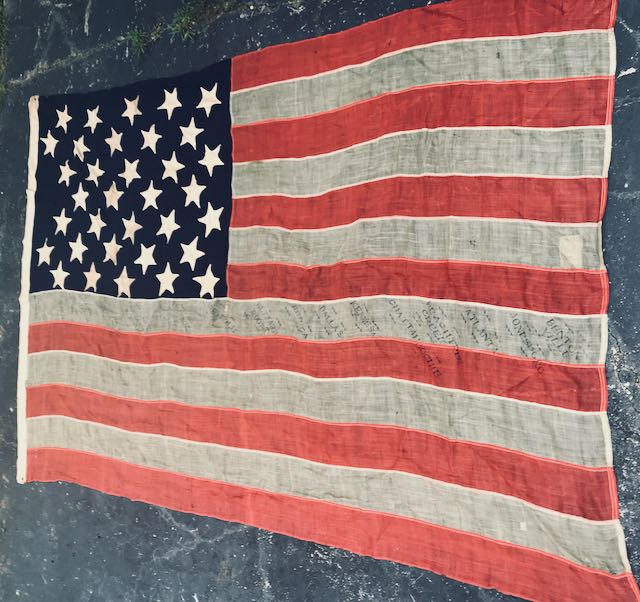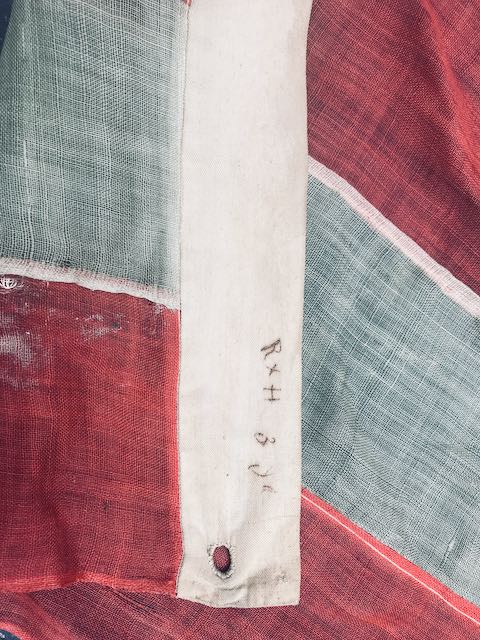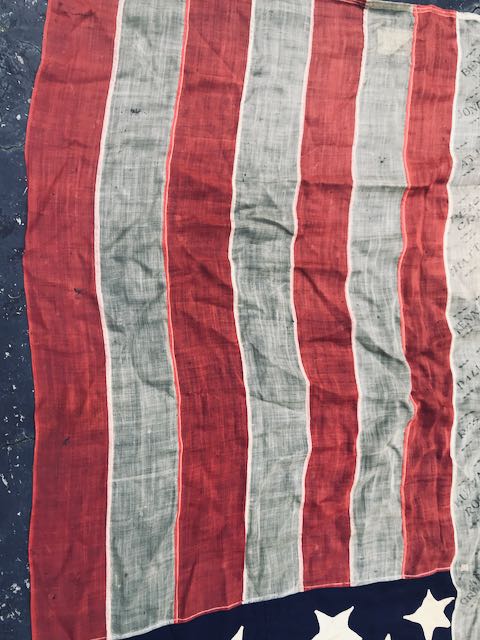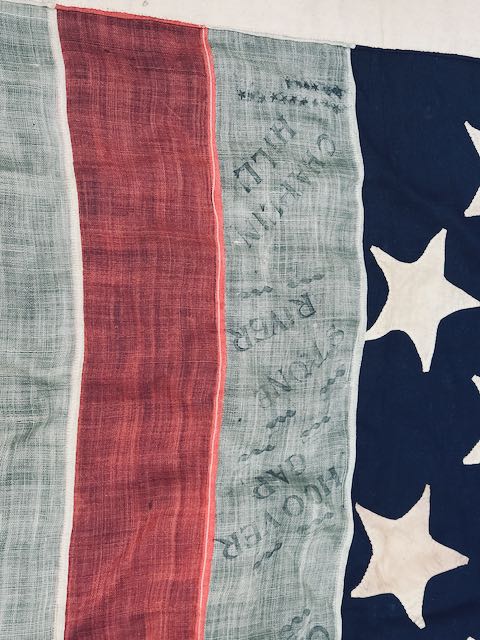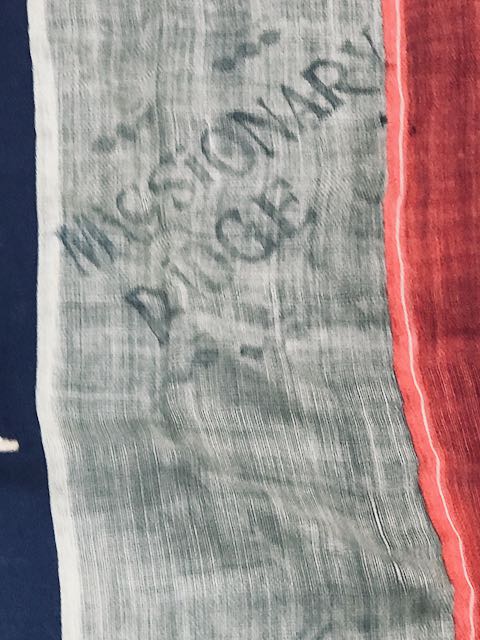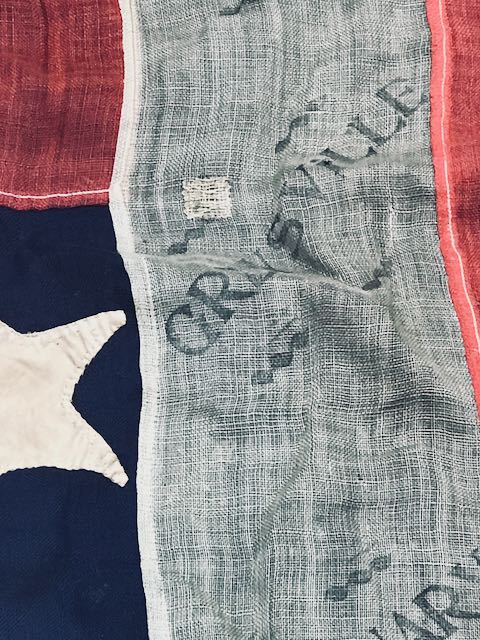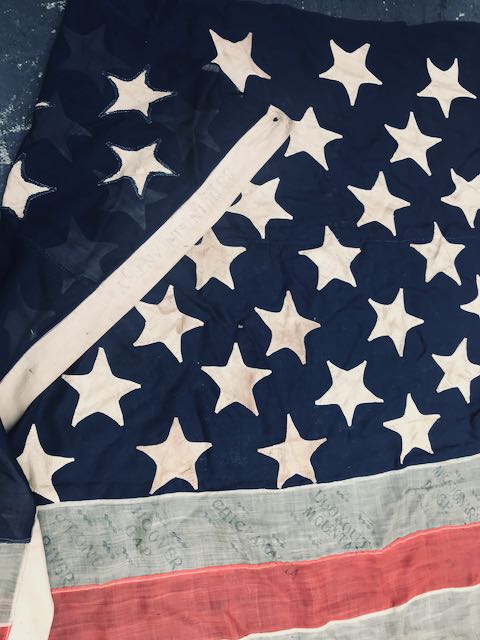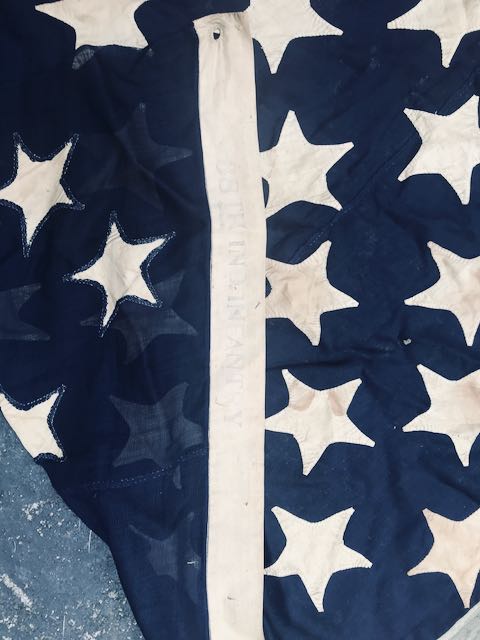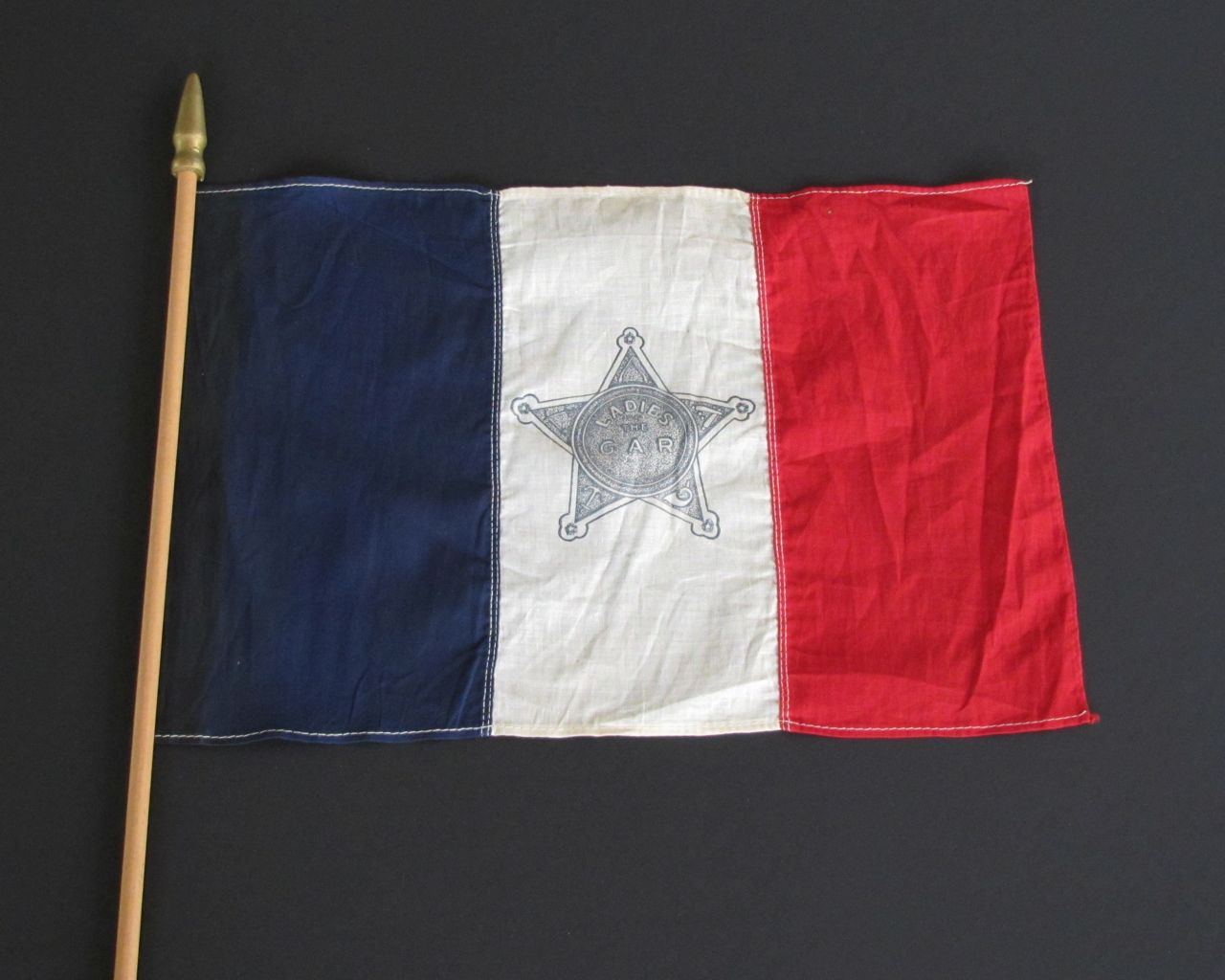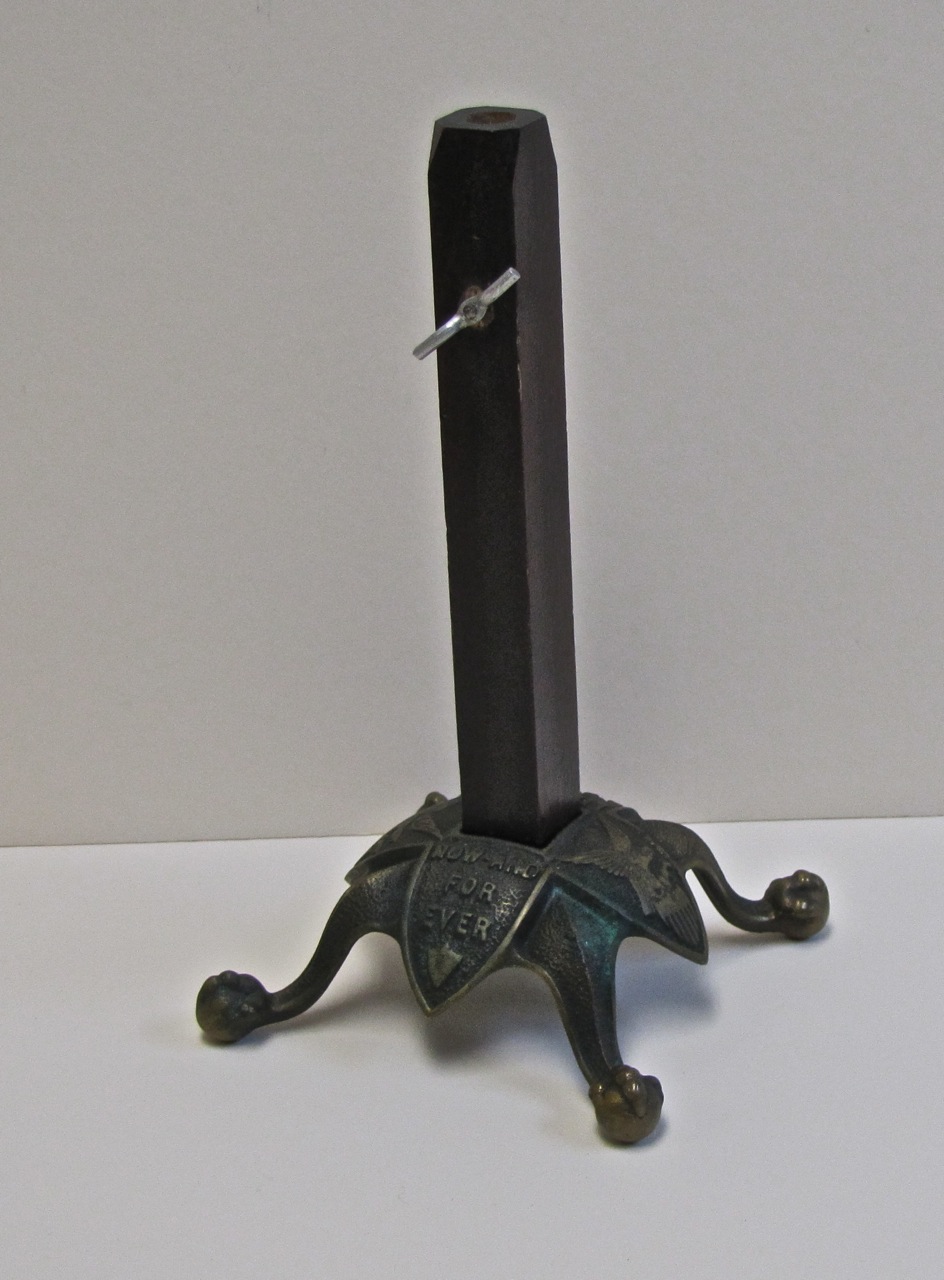Description
Authentic Antique 34 Star Civil War All Hand Sewn American Flag, Circa 1861.
EXCEEDINGLY RARE! CIVIL WAR FLAG WITH ATLANTA CONNECTION.
Most museums do not have a antique flag this good and this rare.
This flag was used in the war and then returned back to its home town and used as a very rare surviving authentic recruiting flag for the unit. All the battles the unit fought in are stenciled on to the flag. The flag was examined by the Civil War department by a major Civil War museum as was found to be a authentic civil war used flag and a very rare flag that was used to recruit new troops as the 35th Star Flag came out and this 34 star flags was retired.
US Army Military ordered & issued civil war flag
62” high 100” wide
The Flag is ID’ed from the 38th Infantry, Illinois and has the initials R x H written on the back of the hoist in period ink.
Individual hand cut & hand sewn stars. In the 5, 5, 5, 4, 5, 5, 5 stars in a row arrangement. The stars are approximately 5 ½” across on a canton that is 36”x49”. The stars are called “peek-a-boo” stars because on the reverse side the blue fabric is cut away in the shape and size of the star and hemmed so the white from the front shows through. This is also a sign of an early flags and fabric shortages due to wartime. The Stripes are made of wool and individually hand treadle sewn. The stripes are 5 ¼”. The hoist is made of canvas and has hand sewn buttonhole type grommets, which is indicative of early flags, as the metal grommets had not been invented yet. The fly end of the flag has double line treadle sewn stitching. The canton is made of two panels of material, which is indicative of fabric shortages in wartime. There are numerous tiny holes throughout the flag and numerous hand sewn stitched repairs.
The highlight features of this flag on top of being a spectacular example of a hand sewn civil war flag is that it also has stenciled names of the battles the Unit fought in. Flags with this feature are especially rare and most are in museums.
The following battles are stenciled on the white stripe:
CHAPLIN HILL Note! This also has 15 stars below the name.
STONE RIVER, HOOVER GAP, CHICKAMAHA, LOOK OUT MOUNTAIN, MISSIONARY RIDGE, GREYSVILLE, BUZZARD ROOST, RESACHA, DALLAS, KENNESAW, CHATTAHOOCHIE, PEACHTREE CREEK, ATLANTA, JONESBORO, BENTONVILLE
Diamond type designs are stenciled around the battle names.
Flag is in very nice condition showing minor use. Packed away and forgotten about till 2011 when it was discovered, and I purchased it. The white has faded to a tan color which is typical. It also has some minor stains and a few holes. There are some rust stains on the hoist as it must have been packed away with something metal.
Canvas hoist with hand sewn buttonhole grommets
The 5” stars are hand cut and sewn. These are called Peek-A-Boo stars as the back side is cut & hemmed. Typical with war shortage of material
The canton is made of three panels which is typical of war time shortages.
Treadle sewn stripes 7” wide
34 Star Hand Sewn Civil War Flag
Voted into the Union on January 29th, 1861 President: A. Lincoln
The thirty-four star flag represents the inclusion of Kansas to the Union. Kansas was admitted on January 29th, 1861, and this flag became official on July 4th, 1861. President Lincoln served, and the Civil War was fought, under this star count. Many thirty-four star flags predate the first shots of the Civil War in 1861, as flag makers began producing them upon the admission of the Kansas, instead of the time at which the flag was officially admitted to the Union later in the same year. The thirty-four star flag was official until July 4th 1863, the time at which the thirty-five star flag became official and began to represent the inclusion of West Virginia in the Union.
Thirty-four and thirty-five star flags were the official flags for the majority of the Civil War, and for this reason, both are extremely collectible. Flags associated with this time period (1861-1865) and earlier are among the rarest and most desirable of all US flags. Prior to the Civil War, Americans did not typically display flags for patriotic purposes. In fact, even the military did not regularly use the flag, as it was not until 1834 that the army field artillery was permitted to carry the traditional US flag, and not until 1841 that regiments carried it. Instead, most flags prior to the Civil War were used to mark ships, and were massive in scale so as to be seen from large distances.
Selling only Genuine Authentic antiques & rare American Flags
I have consulted with numerous museums across the country including The National Archives, PBS, various film production companies for national TV Shows, major motion pictures, major collectors, and large and small auction houses over the years in selling, loaning, describing, documenting, and identifying various antique flags and antique textiles.
I have been interviewed for many national magazines and newspaper articles on antique flags and rare Americana.
Our flags and rare Americana have been featured in numerous antique trade publications, newspapers and major national decorator magazines, national TV shows and major movies.
I have also worked with numerous major retail corporations, major on-line retailers, major on-line catalogs, many prominent national interior designers, and architects.
Historical Americana has been buying and selling rare, unique antique relics and rare American Flags and Americana for over twenty years. I have personally seen and handled and purchased thousands of antiques & antique flags over the years.
Please do not be intimated by dealers that have outrageous prices on their flags and say if any flags is sold for less than their (highly inflated prices) it can’t possibly be real. Really?…
If you want to pay more for the same flag, please do
I have more experience on antique flags than most museum curators, auction house appraisers who may see only a few flags each year and most flag dealers sometime make erroneous statements and opinions on flags because of lack of experience.

